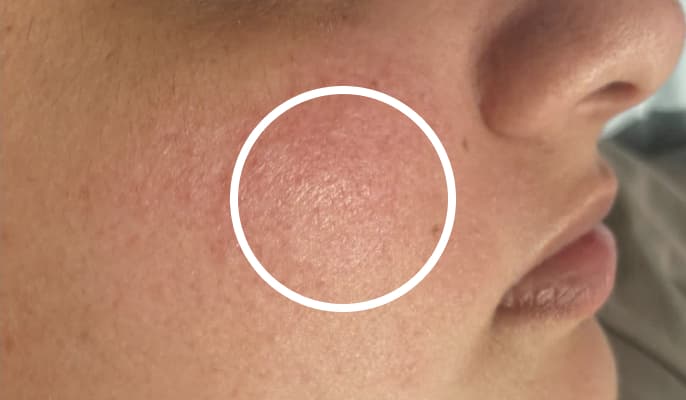About Rosacea
What is Rosacea?
Rosacea is a common, long-term, inflammatory skin condition that mostly tends to affect the centre of the face. The main clinical features of rosacea include transient or persistent redness, flushing or blushing, skin sensitivity, and small, visible broken blood vessels. It can also result in the appearance of pus-filled and red spots which can often be mistaken as acne. There’s no cure for rosacea but it can be controlled and reduced effectively with appropriate treatment. People with rosacea will often have flare-ups that can last for weeks to months as well as periods with no symptoms at all.
The condition used to be called acne rosacea but this is incorrect as we now know that acne and rosacea are separate skin conditions and treatment approaches for them are different. As rosacea affects the face it can have a huge impact on quality of life, social and psychological well being.
What are the features of Rosacea?
The following signs and symptoms are seen in rosacea. Most people with rosacea will usually have a combination of these.
Facial redness
Rosacea tends to cause persistent redness in the centre of the face (nose and cheeks) but it can also affect the chin, forehead, ears and even the chest occasionally.

Flushing or blushing
This is a sudden reddening of the face, neck and sometimes upper chest caused when the skin blood vessels dilate. It can be associated with or without sweating. We all flush and blush from time to time but in rosacea it tends to be more severe and long-lasting (normally for more than 10 minutes). Flushing or blushing are characteristically triggered by numerous factors such as drinking alcohol, changes in temperature, certain foods and after exercise. We discuss triggers in more detail below.
Spots (papules and pustules)
Papules (red, inflammatory spots and pustules (yellow/white pus-filled spots) are often seen in rosacea and tend to affect the skin on the central face. This is the reason why rosacea is often mistaken for acne but a key distinguishing feature is that rosacea does not normally result in blackheads and whiteheads (comedones) which are a key feature of acne. (link to acne page).
Skin sensitivity
This describes an unpleasant burning or stinging sensation of the skin that can be brought on by applying cosmetics, makeup and even when the skin is exposed to changes in temperature.
Broken blood vessels
The medical term for these vessels is “telangiectasia” and they are visible, enlarged, blood vessels in the skin. They are usually found on the central face and also contribute to the redness seen in rosacea.
Skin thickening (rhinophyma)
Rosacea can cause a fibrous thickening of the skin, particularly the skin of the nose which is also accompanied by prominent pores (sebaceous hyperplasia). This feature of rosacea is more commonly seen in men and if left untreated can result in an enlarged, bulbous nose.
Eye symptoms
Rosacea can sometimes affect the eyes where the most common symptoms are red, sore or gritty eyes.
How common is rosacea?
Rosacea is estimated to affect between 5-10% of the global population [1]. It is found most commonly in people with lighter skin tones of Celtic and northern European descent but it can affect people of all skin tones and is increasingly being diagnosed in people with darker skin tones [2]. It’s more commonly diagnosed in females and most cases first develop after the age of 30 although it can develop at any age [3]. It’s most frequently diagnosed in people between the ages of 51 and 60 years old [1].
What causes rosacea?
The underlying cause of rosacea is not fully understood but is thought to be due to a complex interplay between genetics, environmental factors, problems with the blood vessels and nerves in the skin, an overactive immune system and exposure to ultraviolet light.
Microorganisms that live on our skin are also thought to play a role and studies have found that a mite that normally lives in our follicles (called Demodex folliculorum) is found in increased numbers in rosacea sufferers compared to those without rosacea. It’s thought that the presence of this mite may be an important contributing factor in the development of rosacea and some rosacea treatments specifically target this mite [4].
Triggers
There are also a number of factors that can trigger or worsen rosacea. Here is a list of some of the most common triggers compiled from a survey by the National Rosacea Society .
Survey results of common triggers
| Factors | Percent Affected |
|---|---|
| Sun exposure | 81% |
| Emotional stress | 79% |
| Hot weather | 75% |
| Wind | 57% |
| Heavy exercise | 56% |
| Alcohol | 52% |
| Hot baths | 51% |
| Spicy foods | 45% |
| Humidity | 44% |
| Indoor heat | 41% |
| Certain skincare products | 41% |
| Heated beverages | 36% |
| Certain cosmetics | 27% |
| Medications | 15% |
| Medical conditions | 15% |
| Certain fruits | 13% |
| Marinated meats | 10% |
| Certain vegetables | 9% |
| Dairy products | 8% |
| Other factors | 24% |
What may trigger rosacea in one person may not in another which is why people with rosacea are encouraged to keep a skin diary to help them work out what their individual triggers are. A free rosacea diary booklet is available here.
How is rosacea treated?
Rosacea is a chronic condition that needs to be managed in a holistic manner. Although there is no cure, the signs and symptoms can be controlled and reduced through a range of evidence based medical treatment with lifestyle measures, modification of trigger factors and skincare.
Topical treatments: There are a number of effective topical prescription treatments for rosacea and the type of medication prescribed will depend on a person’s signs and symptoms. For example spots and bumps require different treatments than the broken small blood vessels and flushing or blushing and a combination of ingredients is preferred to address the different components of rosacea.
Topical treatments include metronidazole, ivermectin, azelaic acid and brimonidine which each work differently to target the different signs and symptoms of rosacea [5].
Oral antibiotics: various antibiotics (such as Doxycycline, Lymecycline, Minocycline and Azithromycin) have been shown to be effective in treating the spots of rosacea that’s moderate to severe in its severity [5]. Antibiotics’ effectiveness in treating rosacea is thought to be due to their anti-inflammatory properties rather than their effects on bacteria.
Light therapy: light and laser devices such as pulsed dye laser and intense pulsed light therapy have effectiveness in treating the redness and broken blood vessels seen in rosacea [5].
Skincare tips
Skincare and an effective skincare routine is an important adjunct to rosacea treatment.
Protect against UV rays – as damage from UV light is thought to be an important factor in the cause of rosacea it’s essential to apply a broad spectrum sunscreen daily (SPF 50 with good UVA protection). In addition to sunscreen, good sun behaviour involves avoiding the strong midday sunshine and wearing protective clothing and hats.
A simple, gentle skincare routine – cleanse daily with a gentle cleanser (avoid soap and scrubs). It’s best to choose products with minimal ingredients so avoid fragrance and alcohol in your products.
Makeup – some makeups can help hide the visible redness and flushing of rosacea and cosmetic camouflage is helpful in some cases. To find out more about skin camouflage services please follow this link.
Lifestyle tips
Work out your triggers and avoid them – make a trigger diary to work out what lifestyle factors are triggering your rosacea so that you can then try and avoid them.
How does Skin + Me treat rosacea?
At Skin + Me we have an expert dermatological team who are able to diagnose rosacea through the answers to carefully selected questions and uploaded photographs. The team will then be able to prescribe a personalised formulation to treat your rosacea depending on your skin type. The prescription will be delivered to your door within days of completing your consultation. You will then receive further prescriptions each month and the concentrations of key ingredients will be modified to help you tolerate the cream and also increase the strengths of key ingredients. At Skin and Me we understand that not all skins are the same. Treating rosacea can be challenging as often skins are more sensitive and having the ability to alter the strengths of key ingredients over time helps us improve tolerance to help achieve the desired outcomes.
References
- Gether, L., Overgaard, L. K., Egeberg, A., & Thyssen, J. P. (2018). Incidence and prevalence of rosacea: a systematic review and meta‐analysis. British Journal of Dermatology, 179(2), 282-289.https://pubmed.ncbi.nlm.nih.gov/29478264/
- Alexis, A. F., Callender, V. D., Baldwin, H. E., Desai, S. R., Rendon, M. I., & Taylor, S. C. (2019). Global epidemiology and clinical spectrum of rosacea, highlighting skin of color: review and clinical practice experience. Journal of the American Academy of Dermatology, 80(6), 1722-1729.https://pubmed.ncbi.nlm.nih.gov/30240779/
- Thiboutot, D., Anderson, R., Cook-Bolden, F., Draelos, Z., Gallo, R. L., Granstein, R. D., … & Tan, J. (2020). Standard management options for rosacea: the 2019 update by the National Rosacea Society Expert Committee. Journal of the American Academy of Dermatology, 82(6), 1501-1510.https://pubmed.ncbi.nlm.nih.gov/32035944/
- Chang, Y. S., & Huang, Y. C. (2017). Role of Demodex mite infestation in rosacea: a systematic review and meta-analysis. Journal of the American Academy of Dermatology, 77(3), 441-447.https://pubmed.ncbi.nlm.nih.gov/28711190/
- Van Zuuren, E. J., Graber, M. A., Hollis, S., Chaudry, M., Gupta, A. K., & Gover, M. (2006). Interventions for rosacea (Cochrane Review). The Cochrane Library, (1).https://www.cochranelibrary.com/cdsr/doi/10.1002/14651858.CD003262.pub5/full
